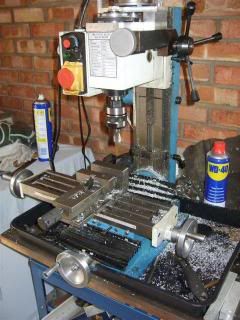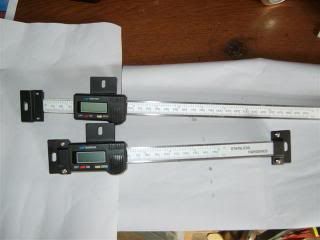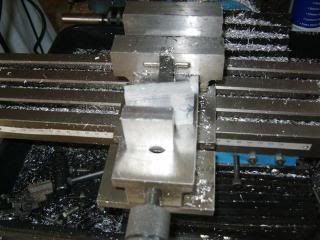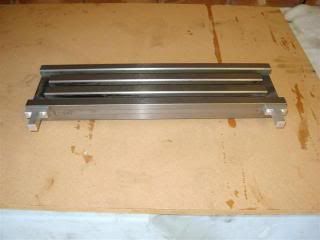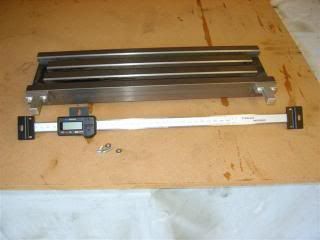You are using an out of date browser. It may not display this or other websites correctly.
You should upgrade or use an alternative browser.
You should upgrade or use an alternative browser.
Mini mill scale retrofit
- Thread starter John Rudd
- Start date

Help Support Home Model Engine Machinist Forum:
This site may earn a commission from merchant affiliate
links, including eBay, Amazon, and others.
I'm currently adding scales to the X and Y axis for the time being...
As for plans I'm using the TLAR approach and a bit of help from some photos I came across over at Madmodder ( thanks for posting up pictures of yours Chris )
So onto some metal butchery...
X axis mounting blocks and the bracket for the lug for the Y axis scale.....
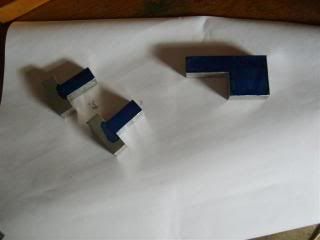
Although cut to size , the blocks require the holes drilling for mounting.
I'll do that after finishing all the machining ops with the milling cutters..Saves a lot of swapping about.
As for plans I'm using the TLAR approach and a bit of help from some photos I came across over at Madmodder ( thanks for posting up pictures of yours Chris )
So onto some metal butchery...
X axis mounting blocks and the bracket for the lug for the Y axis scale.....

Although cut to size , the blocks require the holes drilling for mounting.
I'll do that after finishing all the machining ops with the milling cutters..Saves a lot of swapping about.
Not sure what you mean there.......ttrikalin said:nice start.
Do you plan to use them just for crude positioning, or for actual precision machining -- i.e, how good do you expect the final installation and works to be in terms of accuracy?
t
All things being equal, the accuracy of any machining will be down to the accuracy of the scales surely?
In my (limited) experience the fitting of digital vernier scales allows precision machining to 0.01 of a millimetre - how much more precise do you want to get ? Seriously, after fitting the scales to my mill my level of accuracy improved beyond belief. Well worth the cost and time involved. Go for it - it was the best step forward I ever made.
John-Som
John-Som
was ... thinking (obviously not thinking) that non-parallel positioning of the scales to the datum surfaces of the mill ways might lead to some cosine error -- but this would be too small an issue...
Beg your indulgence mates
t
Beg your indulgence mates
t
ttrikalin said:was ... thinking (obviously not thinking) that non-parallel positioning of the scales to the datum surfaces of the mill ways might lead to some cosine error -- but this would be too small an issue...
Beg your indulgence mates
t
Still not sure what you are saying........Could you elucidate?
Accuracy to within 4 thou is good enough for what we do....Surely?
- Joined
- Aug 8, 2009
- Messages
- 930
- Reaction score
- 12
If there is some misalignment of the beam (DRO) relative to the movement of the table or head or whatever you mount it to, then you get cosine errors because now there is an angle (vector) to take into consideration. No doubt this has to be a substantial misalignment for it to make a detectable difference with the resolutions we're dealing with in this hobby, plus, I'm thinking the DRO readout will probably bind on the beam if it is too far out of alignment.
John, those scales won't make your machining a "little" easier, they will make it a LOT easier.
When you get around to the Z axis, it's best to fit LMS's air lift mod to the mill at the same time. This takes the head drop problem out of the picture and makes room for the DRO on that side of the column. Next to the belt drive mod, this is the best one you can make, in my opinion.
-Trout
John, those scales won't make your machining a "little" easier, they will make it a LOT easier.
When you get around to the Z axis, it's best to fit LMS's air lift mod to the mill at the same time. This takes the head drop problem out of the picture and makes room for the DRO on that side of the column. Next to the belt drive mod, this is the best one you can make, in my opinion.
-Trout
Ok, more effort put in today......
I stripped the mill into its many parts to facilitate the install of the brakcets..Some drilling and tapping needed here and I wasnt looking forward to it...Having no other means of drilling the holes I had to figure out a way of doing this.. ???
Easy answer...make a drilling guide..
I had a spare piece of 16mm thick plate, so I drilled a hole through it (3.3mm ) to guide the twist drill..Duly clamped to the mill table, I succeeded in drilling and tapping...
So first the right side...
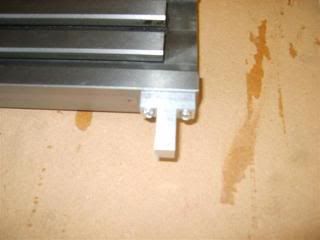
I stripped the mill into its many parts to facilitate the install of the brakcets..Some drilling and tapping needed here and I wasnt looking forward to it...Having no other means of drilling the holes I had to figure out a way of doing this.. ???
Easy answer...make a drilling guide..
I had a spare piece of 16mm thick plate, so I drilled a hole through it (3.3mm ) to guide the twist drill..Duly clamped to the mill table, I succeeded in drilling and tapping...
So first the right side...

Troutsqueezer said:If there is some misalignment of the beam (DRO) relative to the movement of the table or head or whatever you mount it to, then you get cosine errors because now there is an angle (vector) to take into consideration. No doubt this has to be a substantial misalignment for it to make a detectable difference with the resolutions we're dealing with in this hobby, plus, I'm thinking the DRO readout will probably bind on the beam if it is too far out of alignment.
-Trout
My trig is pretty rusty. But it seems that if the scale beam were misaligned by 2 degrees the error would be .0006" per inch. As you say, with a 2 degree misalignment the readout head would be binding severely.
Hi John
I have spent most of today addressing the same exercise on the x axis of my mill (ama25lv) I was fortunate to be able to use the fittings built into the table for the x stops to fit two scale supports but quickly realized the scale was too high! So I have fitted a couple of "drop plates" to facilitate dropping the scale by about 12mm. The physical size of the slider makes life difficult and I have had to surrender a small amount of Y axis movement at its extreme ( the body fouls the cross slide wheel ) I could reduce the length of the stand offs which would be one solution but I wish to retain the use of the stops which I have found useful in the past. I hope to use the centre stop mechanism with an interim plate to fix the slide
Regards
TerryT
I have spent most of today addressing the same exercise on the x axis of my mill (ama25lv) I was fortunate to be able to use the fittings built into the table for the x stops to fit two scale supports but quickly realized the scale was too high! So I have fitted a couple of "drop plates" to facilitate dropping the scale by about 12mm. The physical size of the slider makes life difficult and I have had to surrender a small amount of Y axis movement at its extreme ( the body fouls the cross slide wheel ) I could reduce the length of the stand offs which would be one solution but I wish to retain the use of the stops which I have found useful in the past. I hope to use the centre stop mechanism with an interim plate to fix the slide
Regards
TerryT
John, are you using the fignoggle plans? Their mounting blocks look similar to your photos.
Either way, Fignoggle suggest only making a scale mount at one end of each table, and the bracket attached to the head takes the rest of the weight. They suggest this because if you use a mount at each end of the scale, and there is any misalignment, it may cause binding or undue wear. Regardless, it would resolve your problem of too long a scale.
Either way, Fignoggle suggest only making a scale mount at one end of each table, and the bracket attached to the head takes the rest of the weight. They suggest this because if you use a mount at each end of the scale, and there is any misalignment, it may cause binding or undue wear. Regardless, it would resolve your problem of too long a scale.
Those look like the type of scales with a PCB board embedded in a metal bar. If so, you can just cut them to length. The metal is hard-ish, I just used a cut off wheel in an angle grinder. It's probably not so hard a hascksaw wouldn't work though. Cleaned it up on a belt sander.
Similar threads
- Replies
- 13
- Views
- 707
- Replies
- 13
- Views
- 1K




